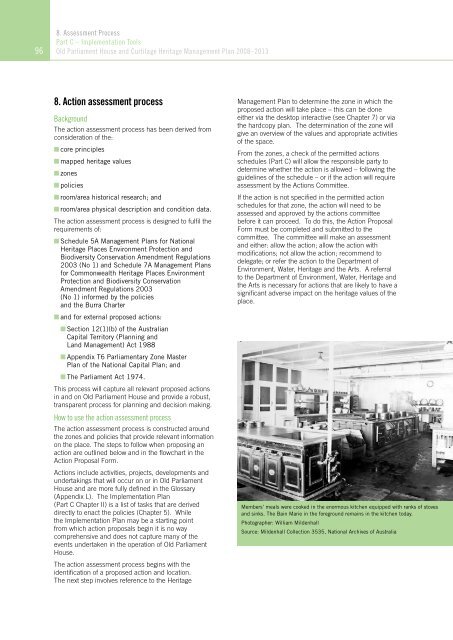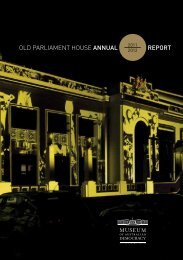OLD PARLIAMENT HOUSE AND CURTILAGE HERITAGE MANAGEMENT PLAN 2008–2013
Heritage Management Plan 2008-2013 - Museum of Australian ...
Heritage Management Plan 2008-2013 - Museum of Australian ...
- No tags were found...
Create successful ePaper yourself
Turn your PDF publications into a flip-book with our unique Google optimized e-Paper software.
8. Assessment Process<br />
Part C – Implementation Tools<br />
96 Old Parliament House and Curtilage Heritage Management Plan <strong>2008–2013</strong><br />
8. Action assessment process<br />
Background<br />
The action assessment process has been derived from<br />
consideration of the:<br />
■■core principles<br />
■■mapped heritage values<br />
■■zones<br />
■■policies<br />
■■room/area historical research; and<br />
■■room/area physical description and condition data.<br />
The action assessment process is designed to fulfil the<br />
requirements of:<br />
■■Schedule 5A Management Plans for National<br />
Heritage Places Environment Protection and<br />
Biodiversity Conservation Amendment Regulations<br />
2003 (No 1) and Schedule 7A Management Plans<br />
for Commonwealth Heritage Places Environment<br />
Protection and Biodiversity Conservation<br />
Amendment Regulations 2003<br />
(No 1) informed by the policies<br />
and the Burra Charter<br />
■■and for external proposed actions:<br />
■■Section 12(1)(b) of the Australian<br />
Capital Territory (Planning and<br />
Land Management) Act 1988<br />
■■Appendix T6 Parliamentary Zone Master<br />
Plan of the National Capital Plan; and<br />
■■The Parliament Act 1974.<br />
This process will capture all relevant proposed actions<br />
in and on Old Parliament House and provide a robust,<br />
transparent process for planning and decision making.<br />
How to use the action assessment process<br />
The action assessment process is constructed around<br />
the zones and policies that provide relevant information<br />
on the place. The steps to follow when proposing an<br />
action are outlined below and in the flowchart in the<br />
Action Proposal Form.<br />
Actions include activities, projects, developments and<br />
undertakings that will occur on or in Old Parliament<br />
House and are more fully defined in the Glossary<br />
(Appendix L). The Implementation Plan<br />
(Part C Chapter II) is a list of tasks that are derived<br />
directly to enact the policies (Chapter 5). While<br />
the Implementation Plan may be a starting point<br />
from which action proposals begin it is no way<br />
comprehensive and does not capture many of the<br />
events undertaken in the operation of Old Parliament<br />
House.<br />
The action assessment process begins with the<br />
identification of a proposed action and location.<br />
The next step involves reference to the Heritage<br />
Management Plan to determine the zone in which the<br />
proposed action will take place – this can be done<br />
either via the desktop interactive (see Chapter 7) or via<br />
the hardcopy plan. The determination of the zone will<br />
give an overview of the values and appropriate activities<br />
of the space.<br />
From the zones, a check of the permitted actions<br />
schedules (Part C) will allow the responsible party to<br />
determine whether the action is allowed – following the<br />
guidelines of the schedule – or if the action will require<br />
assessment by the Actions Committee.<br />
If the action is not specified in the permitted action<br />
schedules for that zone, the action will need to be<br />
assessed and approved by the actions committee<br />
before it can proceed. To do this, the Action Proposal<br />
Form must be completed and submitted to the<br />
committee. The committee will make an assessment<br />
and either: allow the action; allow the action with<br />
modifications; not allow the action; recommend to<br />
delegate; or refer the action to the Department of<br />
Environment, Water, Heritage and the Arts. A referral<br />
to the Department of Environment, Water, Heritage and<br />
the Arts is necessary for actions that are likely to have a<br />
significant adverse impact on the heritage values of the<br />
place.<br />
Members’ meals were cooked in the enormous kitchen equipped with ranks of stoves<br />
and sinks. The Bain Marie in the foreground remains in the kitchen today.<br />
Photographer: William Mildenhall<br />
Source: Mildenhall Collection 3535, National Archives of Australia




